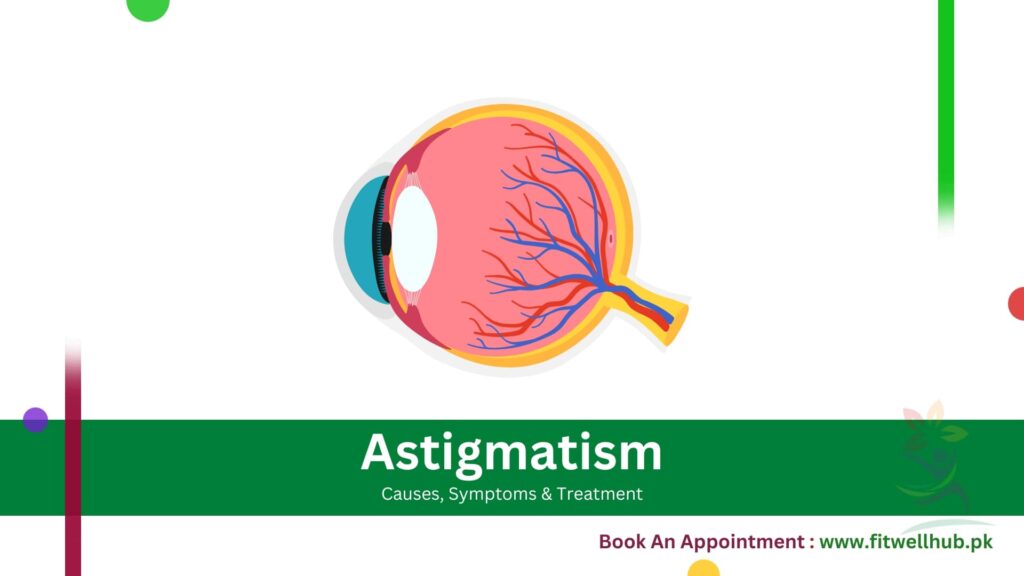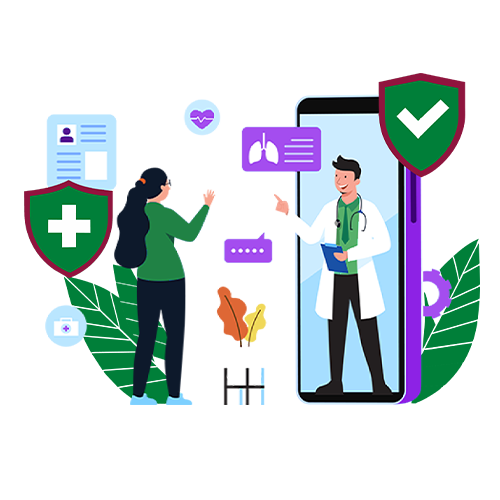Astigmatism is a primary eye condition that leads to distorted or blurred vision because of an irregularly shaped lens or cornea. People with this condition have an irregular shape, similar to a football, instead of a perfect round shape, which stops the light from focusing on the retina properly. This condition can result in vision problems at different distances, frequently causing headaches or discomfort. It can occur along with other refractive errors such as farsightedness (hyperopia) or nearsightedness (myopia).
Quick Links
ToggleIt is a common refractive error rather than a disease, affecting individuals all across Pakistan, and it can be corrected with contact lenses, eyeglasses, or surgery. Most of the people have some degree of astigmatism, but it may go unnoticed if it is mild. More serious cases can cause significant vision problems, and prompt detection is essential to ensure effective treatment and correction.
To learn about allergies, Click HERE!
Symptoms
Astigmatism can manifest through a range of symptoms, some of which are linked to eye strain and vision. Here are a few major symptoms:
- Blurry vision at all distances: People with astigmatism frequently experience distorted or blurred vision, whether trying to focus on something close or far away. This blurriness occurs when light does not focus on the retina properly.
- Eye strain or discomfort: Individuals with uncorrected astigmatism can experience persistent eye strain, particularly when working on a computer, reading, or doing tasks that need sustained focus.
- Headaches: This condition can cause headaches because of the continuous effort needed to focus and see clearly, particularly after extended periods of concentration.
- Difficulty seeing at night: Many individuals with astigmatism experience difficulty seeing clearly at night, especially when driving. The glare from streetlights or headlights can worsen the condition.
- Squinting to see clearly: People with astigmatism may find themselves frequently squinting to sharpen their vision and improve their focus.
- Double vision in severe cases: In more serious cases, some people may have double vision, in which images appear overlapped or are seen double in one eye.
When to See a Doctor
If you have any of the symptoms like persistent headaches, poor night-time vision, or blurry vision, it is important to seek an eye check-up. Early detection can help avoid more complications and discomfort.
Children need to seek routine eye screenings, as uncorrected vision problems can impact development and learning. FitwellHub offers specialist eye doctors who provide full eye checkups and personalized solutions for astigmatism. To book an appointment for the utmost care of your eyes, visit FitwellHub now.
Causes
Astigmatism occurs due to the irregular shape of the lens or cornea, which causes the light to refract incorrectly at the retina. Various factors that can lead to this abnormality are:
- Genetics: It is generally inherited; if one or both of your parents have this condition, you may be more susceptible to developing the condition as well.
- Injury to the eye: Eye injury or trauma may lead to the deformation of the cornea, resulting in astigmatism. This may occur due to contact sports, accidents, or any other form of physical effect on the eye.
- Eye surgery: Certain forms of eye surgeries like those used for cataract removal, can result in postoperative complications as they can change the shape of the cornea resulting in astigmatism.
- Keratoconus: It is a progressive eye problem that makes the cornea thin and swell out into a cone-like shape. This abnormal shape can cause significant astigmatism with time.
- Developmental changes in the cornea: This can occur slowly due to natural variations in the shape of the cornea over time. This is more common in people as they age.
Risk Factors
While every person is at risk of having astigmatism, particular risk factors predispose an individual to the condition or aggravate its severity.
- Family history: A person with a family medical history of astigmatism or other refractive errors like myopia or hyperopia is at a higher risk of developing the condition.
- Nearsightedness or farsightedness: This condition can frequently occur along with myopia or hyperopia, which can cause worsened vision.
- Age: It can occur or worsen with age, particularly as the cornea shape may change with time.
Complications
Astigmatism can result in various complications if not treated well, affecting eye health and overall vision.
1- Blurred vision
If this condition is left untreated, chronic blurry vision can occur, leading to difficulty in seeing clearly at all distances and affecting daily activities.
2- Difficulty with daily activities
Many people with uncontrolled astigmatism have trouble performing normal activities like working on a computer, driving, or reading because of the interference of eye strain and blurred vision with these activities.
3- Development of other eye conditions
It can lead to the development of other refractive problems like farsightedness or nearsightedness. Astigmatism can lead to amblyopia (lazy eye) development, especially in children.
Prevention
Although it can not be completely prevented, some steps can decrease the chances of complications and ensure good eye health.
1- Regular eye exams
It is essential for identifying astigmatism promptly and guaranteeing vision correction properly. Adults should have their eyes checked every 1-2 years, while children may need more frequent exams.
2- Protective eyewear
Wearing protective eyewear during activities that indicate a risk of eye injury, like construction work or contact sports, can assist in preventing trauma to the eye and decrease the chances of developing the condition.
3- Avoid eye strain
Taking regular breaks from activities that can lead to eye strain, like using a computer or reading, can assist in preventing eye fatigue and minimize discomfort related to astigmatism.
4- Maintain eye health
A healthy lifestyle, such as hydration and proper nutrition, can ensure good eye health and decrease the chances of developing eye problems that may lead to astigmatism.
FitwellHub offers wellness programs structured to prevent common health problems such as astigmatism and promote healthy living.
Diagnosis
Diagnosis of astigmatism generally includes a full eye exam that tests vision and measures the curvature of the cornea. With advancements in healthcare technology, diagnostic equipment, including corneal topography and autorefractors, enables eye specialists to measure the curvature of the cornea and identify irregularities with high accuracy.
| Test Name | Description |
|---|---|
| Visual Acuity Test | Measures how well you can see at different distances by asking you to read letters on a chart from a set distance. Helps identify vision issues. |
| Keratometry | Measures the curvature of the cornea to determine the degree of astigmatism by evaluating how light reflects off the cornea. |
| Refraction Test | Identifies the correct lens prescription to correct vision. A phoropter is used to switch lenses and measure their impact on vision. |
| Corneal Topography | Creates a detailed map of the cornea’s surface, providing accurate information about its shape and any abnormalities that may cause astigmatism. |
| Autorefractor | Measures how light changes as it enters the eye, helping determine the degree of refractive error and the shape of the cornea. |
FitwellHub has advanced diagnostic labs and offers state-of-the-art testing for astigmatism and other eye problems. Schedule a complete eye exam today at our lab.
Treatment
Several treatment options available for astigmatism based on the condition’s severity level are:
1- Eyeglasses
This is the most common treatment that contains lenses, helps compensate for cornea irregular shape, and focuses light properly on the retina to correct vision.
2- Contact lenses
It is another popular option for treatment of this condition. Special toric lenses are designed to correct the irregular curvature of the cornea and provide clear vision.
3- Refractive surgery
To reshape the cornea and correct astigmatism permanently, refractive surgery such as PRK or LASIK is used. These procedures use lasers to alter the curvature of the cornea and restore vision.
Medications
While corrective lenses and surgery are primarily used to treat and cure astigmatism, some medications are prescribed to treat symptoms or conditions that contribute to, even exacerbate astigmatism.
- Artificial tears: Artificial tears are beneficial for individuals with astigmatism and dry eyes because they help lubricate the eyes and reduce discomfort. To effectively prevent dryness and irritation, it is recommended to use over-the-counter eye drops regularly.
- Anti-inflammatory drops: If corneal inflammation contributes to or worsens astigmatism, anti-inflammatory eye drops may be prescribed, which help to reduce swelling, alleviate discomfort, and improve vision.
- Antihistamine drops: These eye drops are convenient for eye allergies, as they relieve itching, like anal itching and redness in the eyes and reduce the chances of discomfort resulting from astigmatism.
FitwellHub pharmacy offers a wide range of medicines for eyecare, such as prescription eye drops. Visit our pharmacy today to place an order for your prescription medications.
Frequently Asked Questions (FAQ’s)
Astigmatism may be present from birth, but it can also arise later as a result of trauma, surgery, or conditions like keratoconus.
No, it does not cause blindness; however, neglected astigmatism may result in complications, such as amblyopia (lazy eye), particularly in children.
Symptoms include blurry vision, eye strain, headaches, poor vision at night, and squinting for clear vision.
Tests like visual acuity, keratometry, refraction, and corneal topography measure the shape of the cornea and determine refractive errors.
Both are effective; the choice depends on your lifestyle and preferences. Contact lenses, especially toric ones, may provide better correction for higher degrees of astigmatism.














